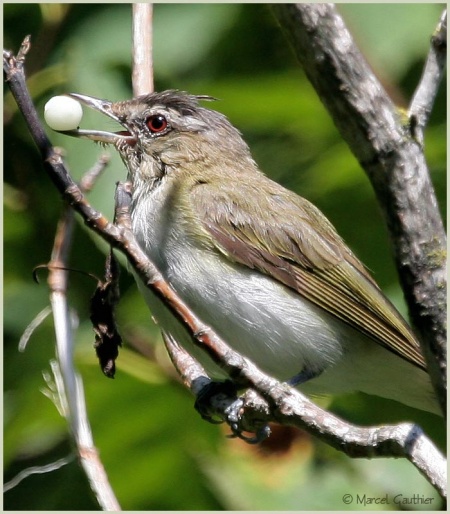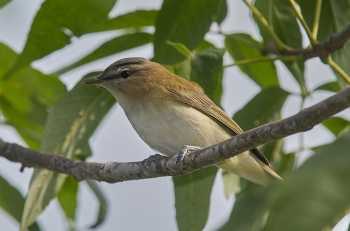- Vireo olivaceus
Identification
13·8–15·6 cm (5½-6 in)
Sparrow-sized. Olive green above, whitish below, with a narrow white eyebrow bordered above with black. Gray crown. No wing bars.
Red eye in adult northern migratory birds; eye dark in immature and brown in adult birds breeding in South America.
Similar Species
Warbling Vireo similar, but lacks gray crown and black border over bold white eyebrow. Similar to a number of species, including Black-whiskered Vireo, Cuban Vireo and others.
Distribution
Canada, western-central and eastern United States. Winters Cuba and central South America.
Canada, United States, Central America, Caribbean, South America, Spain, and Pacific Islands.
Species known as a vagrant in western Europe.
Taxonomy
This is a monotypic species[1].
Chivi Vireo was formerly included in this species.
Habitat
Deciduous woods.
Behaviour
Often heard but seldom seen.
Diet
Forages slowly high in trees.
Their summer diet is mostly insectivorous, especially caterpillars, with the addition of other insects, such as moths and butterflies, beetles, ants, grasshoppers, etc. During the autumn and winter they switch to a variety of seeds and berries.
Breeding
The cup nest is suspended below a branch. It is built by the female with help from the male. The clutch consists of 1-5 white eggs with sepia speckles. Incubation takes 11-15 days.
Vocalisation
A series of hurried phrases. Not burry like most vireos.
<flashmp3>002 July 20.16 morning side Park.mp3</flashmp3>
Listen in an external program
Recording by eiguoc
Toronto, Canada, July 2016
References
- Clements, J. F., T. S. Schulenberg, M. J. Iliff, S. M. Billerman, T. A. Fredericks, B. L. Sullivan, and C. L. Wood. 2019. The eBird/Clements Checklist of Birds of the World: v2019. Downloaded from http://www.birds.cornell.edu/clementschecklist/download/
- Restall et al. 2006. Birds of Northern South America. Yale University Press. ISBN 9780300124156
- Ridgely and Tudor 2009. Field guide to the songbirds of South America - The Passerines. University of Texas Press. ISBN 978-0-292-71979-8
- Neotropical Birds
- Lepage D. (2020) [Avibase - https://avibase.bsc-eoc.org/checklist.jsp?region=ES ]. Retrieved 27 December 2020
- Cimprich, D. A., F. R. Moore, and M. P. Guilfoyle (2020). Red-eyed Vireo (Vireo olivaceus), version 1.0. In Birds of the World (P. G. Rodewald, Editor). Cornell Lab of Ornithology, Ithaca, NY, USA. https://doi.org/10.2173/bow.reevir1.01
Recommended Citation
- BirdForum Opus contributors. (2024) Red-eyed Vireo. In: BirdForum, the forum for wild birds and birding. Retrieved 15 June 2024 from https://www.birdforum.net/opus/Red-eyed_Vireo
External Links





